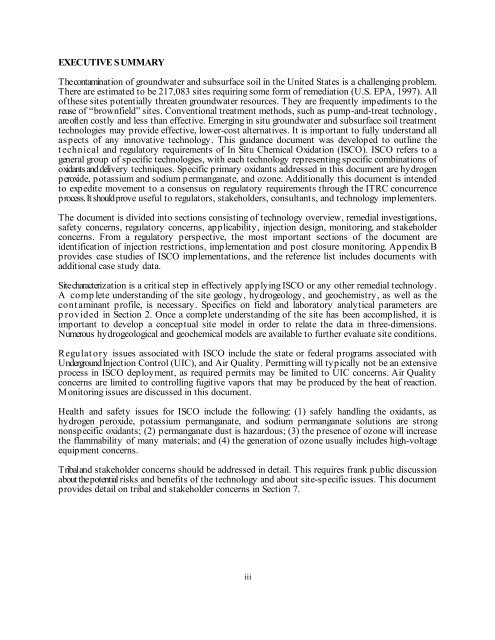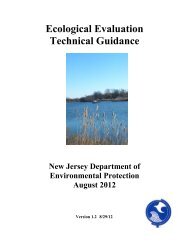Technical and Regulatory Guidance for In Situ Chemical ... - ITRC
Technical and Regulatory Guidance for In Situ Chemical ... - ITRC
Technical and Regulatory Guidance for In Situ Chemical ... - ITRC
Create successful ePaper yourself
Turn your PDF publications into a flip-book with our unique Google optimized e-Paper software.
EXECUTIVE S UMMARY<br />
The contamination of groundwater <strong>and</strong> subsurface soil in the United States is a challenging problem.<br />
There are estimated to be 217,083 sites requiring some <strong>for</strong>m of remediation (U.S. EPA, 1997). All<br />
of these sites potentially threaten groundwater resources. They are frequently impediments to the<br />
reuse of “brownfield” sites. Conventional treatment methods, such as pump-<strong>and</strong>-treat technology,<br />
are often costly <strong>and</strong> less than effective. Emerging in situ groundwater <strong>and</strong> subsurface soil treatment<br />
technologies may provide effective, lower-cost alternatives. It is important to fully underst<strong>and</strong> all<br />
aspects of any innovative technology. This guidance document was developed to outline the<br />
t echnical <strong>and</strong> regulatory requirements of <strong>In</strong> <strong>Situ</strong> <strong>Chemical</strong> Oxidation (ISCO). ISCO refers to a<br />
general group of specific technologies, with each technology representing specific combinations of<br />
oxidants <strong>and</strong> delivery techniques. Specific primary oxidants addressed in this document are hydrogen<br />
peroxide, potassium <strong>and</strong> sodium permanganate, <strong>and</strong> ozone. Additionally this document is intended<br />
to expedite movement to a consensus on regulatory requirements through the <strong>ITRC</strong> concurrence<br />
process. It should prove useful to regulators, stakeholders, consultants, <strong>and</strong> technology implementers.<br />
The document is divided into sections consisting of technology overview, remedial investigations,<br />
safety concerns, regulatory concerns, applicability, injection design, monitoring, <strong>and</strong> stakeholder<br />
concerns. From a regulatory perspective, the most important sections of the document are<br />
identification of injection restrictions, implementation <strong>and</strong> post closure monitoring. Appendix B<br />
provides case studies of ISCO implementations, <strong>and</strong> the reference list includes documents with<br />
additional case study data.<br />
Site characterization is a critical step in effectively applying ISCO or any other remedial technology.<br />
A comp lete underst<strong>and</strong>ing of the site geology, hydrogeology, <strong>and</strong> geochemistry, as well as the<br />
cont aminant profile, is necessary. Specifics on field <strong>and</strong> laboratory analytical parameters are<br />
p rovided in Section 2. Once a complete underst<strong>and</strong>ing of the site has been accomplished, it is<br />
important to develop a conceptual site model in order to relate the data in three-dimensions.<br />
Numerous hydrogeological <strong>and</strong> geochemical models are available to further evaluate site conditions.<br />
Regulat ory issues associated with ISCO include the state or federal programs associated with<br />
Underground <strong>In</strong>jection Control (UIC), <strong>and</strong> Air Quality. Permitting will typically not be an extensive<br />
process in ISCO deployment, as required permits may be limited to UIC concerns. Air Quality<br />
concerns are limited to controlling fugitive vapors that may be produced by the heat of reaction.<br />
Monitoring issues are discussed in this document.<br />
Health <strong>and</strong> safety issues <strong>for</strong> ISCO include the following: (1) safely h<strong>and</strong>ling the oxidants, as<br />
hydrogen peroxide, potassium permanganate, <strong>and</strong> sodium permanganate solutions are strong<br />
nonspecific oxidants; (2) permanganate dust is hazardous; (3) the presence of ozone will increase<br />
the flammability of many materials; <strong>and</strong> (4) the generation of ozone usually includes high-voltage<br />
equipment concerns.<br />
Tribal <strong>and</strong> stakeholder concerns should be addressed in detail. This requires frank public discussion<br />
about the potential risks <strong>and</strong> benefits of the technology <strong>and</strong> about site-specific issues. This document<br />
provides detail on tribal <strong>and</strong> stakeholder concerns in Section 7.<br />
iii
















